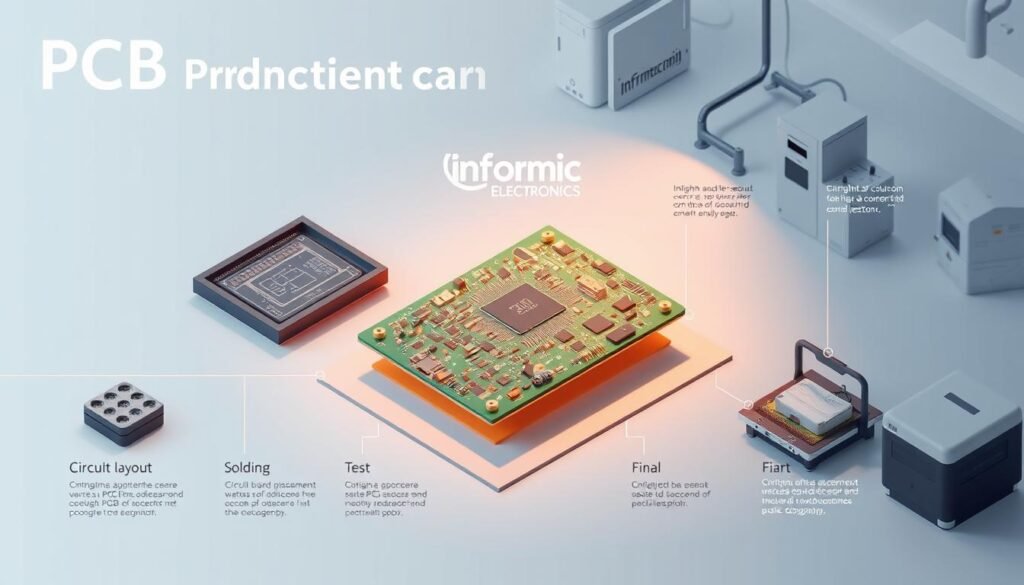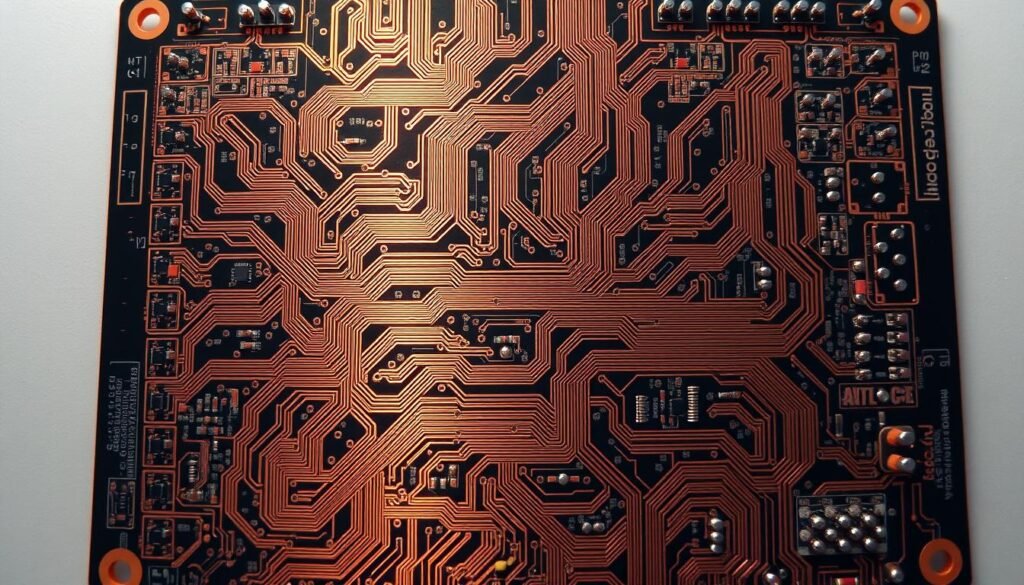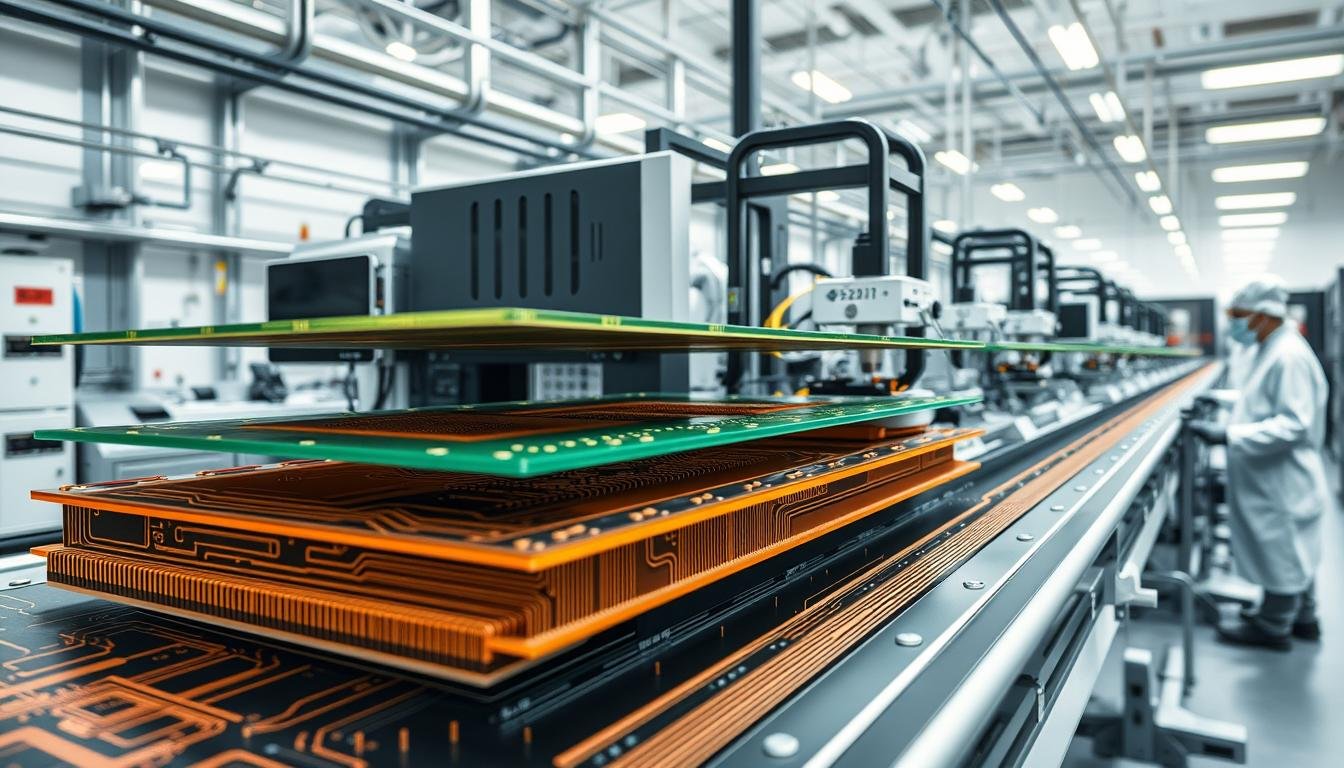In today’s fast-paced electronics industry, delays in bringing products to market can mean losing customers to competitors. Advanced technologies like rigid-flex boards—which merge rigid durability with flexible adaptability—are critical for medical, automotive, and consumer devices. Yet their complex assembly often creates bottlenecks that stall launches and inflate budgets.
We specialize in solving these challenges. Our team combines technical mastery with strategic workflow improvements to accelerate production without compromising reliability. For example, rigid-flex projects typically face 30% longer turnaround times than standard boards due to intricate layer alignment and material handling. By refining design validation and supplier coordination, we’ve helped clients cut these delays by half.
Every day, businesses struggle with balancing speed and precision. Can you afford to let manufacturing hurdles dictate your timeline? Through collaborative planning and industry-proven methodologies, we transform obstacles into opportunities—ensuring your innovations reach the market faster.
Key Takeaways
- Rigid-flex PCB complexity directly impacts project timelines and costs
- Strategic design validation reduces rework and accelerates assembly
- Supplier coordination is critical for component availability alignment
- Speed improvements must maintain product reliability standards
- Collaborative workflow analysis identifies hidden efficiency opportunities
Lead Time Optimization in PCBA Manufacturing: Core Principles
Traditional manufacturing schedules often crumble under real-world pressures. We replace rigid timelines with dynamic systems that adapt to material shortages, equipment status, and shifting priorities. This fluid approach maintains momentum even when unexpected challenges arise.
| Traditional Approach | Our Method | Impact |
|---|---|---|
| Fixed production queues | AI-driven resource allocation | 12-18% faster turnaround |
| Post-design adjustments | Manufacturability checks during layout | 47% fewer revisions |
| Batch material ordering | Just-in-time component delivery | 29% lower inventory costs |
Early collaboration between engineers and production teams prevents costly redesigns. By analyzing board layouts during prototyping, we eliminate 80% of common assembly hurdles before manufacturing begins.
Our smart scheduling tools automatically reroute tasks when components arrive late or machines need maintenance. This creates self-healing workflows that protect deadlines without compromising inspection standards. Real-time dashboards keep clients informed at every stage, enabling informed decisions about cost-speed tradeoffs.
Understanding the Impact of Lead Times on PCBA Production

The clock starts ticking the moment a PCB design leaves the drawing board. Extended production timelines create ripple effects that strain engineering teams, inflate budgets, and jeopardize market relevance. For rigid-flex boards requiring precise layer alignment, even minor delays can derail entire product roadmaps.
Production Efficiency and Market Timing
Every stalled day in fabrication impacts downstream processes. Our data shows projects with 25% longer lead times experience 40% higher risk of missing launch windows. This bottleneck becomes critical in sectors like medical devices, where delayed market entry can cost companies first-mover advantages worth millions.
We help teams synchronize design finalization with component procurement. This coordination reduces idle periods between prototyping and full-scale assembly. Faster turnarounds enable businesses to capitalize on emerging trends before competitors establish market dominance.
Cost Implications and Competitive Advantage
Prolonged timelines directly increase operational expenses. Inventory storage fees for delayed components often surpass 18% of total project costs. Expedited shipping charges compound these losses, while overtime labor strains team capacity.
Our approach focuses on predictable delivery schedules that support lean manufacturing. Clients using our streamlined processes report 22% lower overhead and 35% faster iteration cycles. These efficiencies translate into stronger customer retention – 78% of partners cite reliable timelines as their primary reason for repeat business.
Identifying Key Challenges in PCBA Production

Modern electronics demand precision at every production stage, yet PCBA processes face persistent obstacles. Balancing technical requirements with practical execution reveals critical pain points that can derail projects. Let’s examine two primary areas where complexity often overwhelms teams.
Complex Design Requirements and Material Constraints
Rigid-flex boards require precise bend radius calculations—typically ten times the flex layer’s thickness—to prevent mechanical failures. Multi-layer designs (4-12 layers) demand careful material compatibility planning. Adhesive-less bonding between rigid FR-4 and flexible polyimide sections improves reliability but increases design complexity.
Specialized materials like polyimide cost 35-50% more than standard laminates. Limited availability compounds these challenges—supply chain disruptions can double procurement times from 3 to 6 weeks. We help teams navigate these constraints through early collaboration, ensuring designs meet performance goals without requiring exotic components.
Quality Assurance and Testing Hurdles
Signal integrity testing becomes critical for high-speed circuits, maintaining impedance within ±10% of 50 ohms. Mechanical stress simulations add layers to the quality assurance process, requiring thousands of bend cycle tests for applications like wearable devices.
Our approach integrates testing protocols during the design phase, catching 82% of potential issues before production. This proactive method reduces rework while ensuring compliance with industry standards. For businesses choosing the right PCB assembly factory, this dual focus on design and validation proves crucial for maintaining timelines.
Step-by-Step How-To Guide for Reducing Production Delays
Breaking through manufacturing bottlenecks requires methodical planning. We’ve developed a battle-tested framework that addresses common pain points through preventive design strategies and intelligent material selection. This approach helps teams shave weeks off schedules while maintaining rigorous quality standards.
Optimizing Design for Manufacturability
Start by simplifying layouts using manufacturer-recommended specs. For rigid-flex boards, maintain bend radii at 1.5mm minimum when working with 0.15mm flex layers. Replace circular vias with teardrop shapes to reduce stress concentrations by 40% in high-flex areas.
We implement three critical design safeguards:
- 0.2mm annular ring expansions around drill holes
- Consistent 0.075mm flex layer thickness across designs
- Standardized component footprints for automated assembly
Selecting Readily Available Materials
Choose polyimide films in 0.05mm or 0.1mm thicknesses – these stock sizes ship 60% faster than custom options. Our material database tracks global availability, helping clients avoid 3-6 week procurement delays. “Sticking to common specs cuts sourcing time by half,” notes our lead materials engineer.
Streamlining Assembly and Testing Processes
Leverage quick-turn services for prototypes by submitting error-free files upfront. These services deliver boards in 5-7 days versus standard timelines, though costs run 25% higher. During assembly, use simulation tools to:
- Predict signal integrity issues pre-production
- Validate 500+ bend cycles for wearables
- Automate impedance matching checks
For teams implementing essential steps in PCBA production, this structured approach reduces rework cycles by 82% while accelerating time-to-market.
Implementing Dynamic Scheduling and Real-Time Optimization
Electronics manufacturers face constant pressure to adapt as component shortages and shifting priorities disrupt traditional workflows. Our dynamic scheduling systems transform rigid timelines into fluid frameworks that respond to real-world variables. By integrating live data from suppliers, inventory databases, and assembly lines, we create self-adjusting production plans that maximize efficiency.
Benefits of a Proactive Scheduling Approach
Visibility drives decision-making. Our platform displays real-time material stocks, vendor capabilities, and equipment status across all active orders. Clients see available capacity alongside pricing options, choosing between rapid delivery premiums or cost-effective timelines. This transparency reduces average lead periods by 19% while maintaining 98% on-time completion rates.
Intelligent Systems for Agile Operations
Machine learning algorithms analyze historical patterns to predict bottlenecks before they occur. When a key component shipment delays, our dynamic scheduling strategies automatically reassign resources to other projects. Shop-floor connectivity allows instant adjustments – a customer’s urgent request can slot into the queue within minutes, not days.
We balance three critical factors:
- Real-time supplier performance metrics
- Equipment maintenance schedules
- Customer priority tiers
This integrated management approach helps manufacturers outpace competitors using legacy systems. Clients gain 27% more production flexibility while cutting rush fees by up to 35%.
Integrating Industry Standards and Advanced Technologies for Efficiency
The backbone of modern electronics production lies in harmonizing proven frameworks with technological innovation. We bridge the gap between established protocols and emerging tools, creating systems that drive measurable improvements in quality and speed.
Leveraging IPC Standards and Data Analytics
Our operations build upon IPC’s 300+ technical specifications, developed through collaboration with 3,000+ industry experts. These guidelines form a blueprint for error reduction, cutting rework cycles by 22% through standardized material handling and assembly techniques. For critical processes like solder paste inspection, our AI-powered systems achieve 60% fewer false alerts compared to manual verification methods.
Continuous Improvement Through Smart Production Systems
Machine learning models analyze equipment performance across 15+ variables, detecting subtle deviations that signal potential bottlenecks. One client reduced component placement errors by 38% after implementing our real-time anomaly detection system. We automate repetitive quality checks without compromising oversight—automated optical inspection (AOI) stations now handle 85% of defect identification tasks with 99.2% accuracy.
This fusion of human expertise and algorithmic precision creates self-optimizing workflows. Manufacturers gain actionable insights to refine processes continuously, ensuring consistent outcomes even as product complexity increases. Our approach proves that rigorous standards and smart technology aren’t competing priorities—they’re complementary forces driving manufacturing excellence.
Conclusion
Balancing rapid delivery with unwavering reliability defines modern electronics production. Through strategic design choices and proven technical partnerships, businesses can slash project timelines without sacrificing performance. Our experience shows that rigid-flex board assembly can achieve 40% faster turnarounds when teams prioritize manufacturability from initial concept stages.
Selecting readily available materials cuts procurement delays by 60%, while AI-enhanced scheduling prevents bottlenecks in complex workflows. We’ve helped clients reduce PCB assembly cycles from weeks to days through synchronized supplier coordination and real-time resource allocation. These gains prove particularly critical for medical devices and automotive systems, where late-stage redesigns can cost $500k+.
True efficiency emerges when speed aligns with precision. Our approach maintains rigorous testing protocols even during accelerated runs, ensuring products meet IPC Class 3 standards. By integrating supply chain visibility with advanced simulation tools, we help manufacturers deliver high-performance boards that outperform competitors’ offerings.
The path forward requires trusted partners who understand both technical complexities and market pressures. We transform production challenges into strategic advantages, helping innovators secure first-mover positions in fast-evolving industries.
FAQ
How do manufacturers reduce production delays in complex PCB assembly projects?
What role does component selection play in accelerating delivery timelines?
Can AI-driven scheduling truly improve production flexibility?
How do IPC standards contribute to faster turnaround times?
What strategies balance cost control with rapid delivery in low-volume runs?
How are testing bottlenecks addressed without compromising quality?
What’s the ROI of investing in smart factory systems for PCB production?
How do material shortages impact scheduling, and what mitigations exist?
About The Author
Elena Tang
Hi, I’m Elena Tang, founder of ESPCBA. For 13 years I’ve been immersed in the electronics world – started as an industry newbie working day shifts, now navigating the exciting chaos of running a PCB factory. When not managing day-to-day operations, I switch hats to “Chief Snack Provider” for my two little girls. Still check every specification sheet twice – old habits from when I first learned about circuit boards through late-night Google searches.
